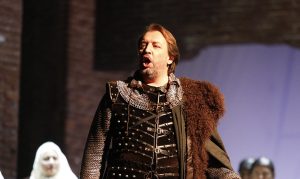May’s Finale at the Maggio Musicale Festival

The second lyric offering at this year’s Maggio Musicale Festival, a rarely performed opera by Giuseppe Verdi, La Battaglia di Legnano (The Battle of Legnano), was composed in 1848 when Verdi was living in Paris.
The opera, a fictional tale of love, jealousy, heroism and patriotism, is set in 1176, during the actual battle of Legnano, when the rival cities of Milan and Como banded together as the Lombard League to defeat German invaders led by the Holy Roman Emperor, Frederick Barbarossa. The stage direction, set in the time of the action, has been entrusted to the award-winning Italian director and screenwriter, Marco Tullio Giordano, while the orchestra will be led by Renato Palumbo in four performances from May 22-31.
Verdi had been encouraged to write an opera reflecting the patriotism current during the Risorgimento, the period leading to the unification of Italy. Composed on a commission from the Teatro Argentina in Rome, the premiere of the La Battaglia di Legnano (The Battle of Legnano) on January 29, 1849 was a huge success. Considering the nationalistic fervor of the time, people were heard humming tunes from the opera in the days following.
American conductor John Axelrod will lead the Maggio Musicale Orchestra in a May 24 concert that opens with Leonard Bernstein’s Symphony n. 2, The Age of Anxiety, scored for orchestra and solo piano. Composed in 1948-49, the work was inspired by the W. H. Auden poem of the same name. The second half of the program features the Symphony n. 4 of Dmitri Shostakovich, written between 1935-36. The symphony, however, was withdrawn from performance after Shostakovich received some very negative criticism about his work in the official Communist Party newspaper “Pravda,” presumably by Stalin. The piece was not performed until 1961 when it was premiered by Kiril Kondrashin in Moscow.
Fabio Luisi, the Maggio Musicale Fiorentino’s music director, returns on May 29 to conduct Felix Mendelssohn’s massive oratorio Paulus (1836). In 1835 Mendelssohn was devastated by the death of his father, Abraham, whose dearest wish had been that his son should complete the work. Using the New Testament, particularly the Gospels and the Acts of the Apostles as sources, Mendelssohn wrote his own version of Paul’s story. The work is scored for full orchestra, chorus and four vocal soloists.
For more information on the Maggio Musicale Festival, see the Opera di Firenze website. (anne lokken)
